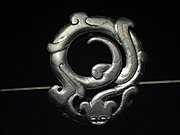Jewellery making in Asia started in China 5,000 years ago and in the Indus Valley region later on.
China
The earliest culture to begin making jewellery in Asia was the Chinese around 5,000 years ago. Chinese jewellery designs were very religion-orientated and contained Buddhist symbols, a fact which remains to this day.

The Chinese used silver in their jewellery more often than gold, and decorated it with their favourite colour, blue. Blue kingfisher feathers were tied onto early Chinese jewellery and later, blue gems and glass were incorporated into designs. However, Chinese preferred jade over any other stone. They fashioned it using diamonds. The Chinese revered jade because of the human-like qualities they assigned to it, such as its hardness, durability and beauty.The first jade pieces were very simple, but as time progressed, more complex designs evolved. Jade rings from between the 4th and 7th centuries BCE show evidence of having been worked with a compound milling machine; hundreds of years before the first mention of such equipment in the west.
In China, jewellery was worn frequently by both sexes to show their nobility and wealth. However, in later years, it was used to accentuate beauty. Women wore highly detailed gold and silver head dresses and other items, while men wore decorative hat buttons which showed rank and gold or silver rings. Woman also wore strips of gold on their foreheads, much like women in the Indus Valley. The band was an early form of tiara and was often decorated with precious gems. The most common piece of jewellery worn by Chinese was the earring, which was worn by both men and women. Amulets were also common too, often with a Chinese symbol or dragon. In fact, dragons, Chinese symbols and also phoenixes were frequently depicted on jewellery designs.
The Chinese often placed their jewellery in their graves; most Chinese graves found by archaeologists contain decorative jewellery.
India
The Indian subcontinent has the longest continuous legacy of jewellery making anywhere. While Western traditions were heavily influenced by waxing and waning empires, India enjoyed a continuous development of art forms for some 5000 years. One of the first to start jewellery making were the peoples of the Indus Valley Civilization. By 1,500 BC the peoples of the Indus Valley were creating gold earrings and necklaces, bead necklaces and metallic bangles. Before 2,100 BC, prior to the period when metals were widely used, the largest jewellery trade in the Indus Valley region was the bead trade. Beads in the Indus Valley were made using simple techniques. First, a bead maker would need a rough stone, which would be bought from an eastern stone trader. The stone would then be placed into a hot oven where it would be heated until it turned deep red, a colour highly prized by people of the Indus Valley. The red stone would then be chipped to the right size and a hole drilled through it with primitive drills. The beads were then polished. Some beads were also painted with designs. This art form was often passed down through family; children of bead makers often learnt how to work beads from a young age.
Jewellery in the Indus Valley was worn predominantly by females, who wore numerous clay or shell bracelets on their wrists. They were often shaped like doughnuts and painted black. Over time, clay bangles were discarded for more durable ones. In India today, bangles are made out of metal or glass. Other pieces that women frequently wore were thin bands of gold that would be worn on the forehead, earrings, primitive brooches, chokers and gold rings. Although women wore jewellery the most, some men in the Indus Valley wore beads. Small beads were often crafted to be placed in men and women’s hair. The beads were about one millimetre long.
A female skeleton (presently on display at the National Museum, New Delhi, India) wears a carlinean bangle ( a bracelet) on her left hand.
India was the first country to mine diamonds, with some mines dating back to 296 BC. India traded the diamonds, realising their valuable qualities. This trade almost vanished 1,000 years after Christianity grew as a religion, as Christians rejected the diamonds which were used in Indian religious amulets. Along with Arabians from the Middle East restricting the trade, India’s diamond jewellery trade lulled.
Today, many of the jewellery designs and traditions are still used and jewellery is commonplace in Indian ceremonies and weddings.
No comments:
Post a Comment